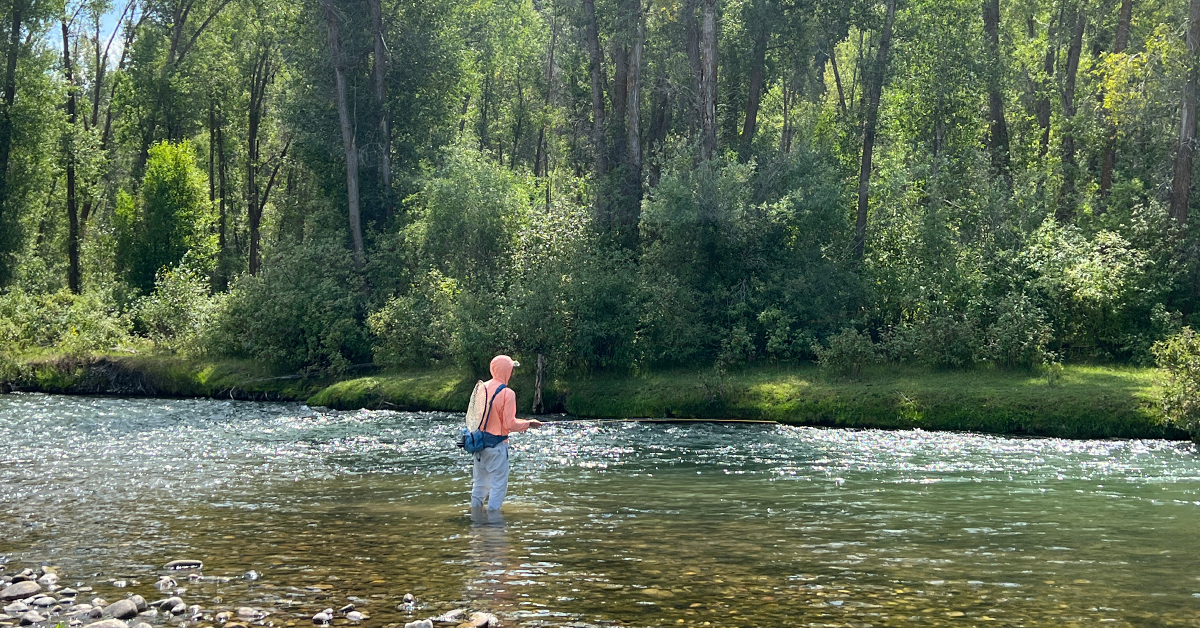Learning about fly fishing can be overwhelming. It is helpful to read about the sport and lay a solid foundation of knowledge before selecting gear and hitting the water.
What is fly fishing?
Fly fishing is a centuries-old fishing method designed to catch fish with artificial lures called flies. Fly fishing’s roots date all the way back to the 2nd Century in Rome! Historically, flies mimicked bugs floating on the water’s surface and were made of feathers, animal hair, or other natural resources found in the environment. Trout were the primary target.
However, fly fishing has evolved a ton over the years. Modern fly fishing methods target many different fish species across numerous environments. Thanks to modern technology, there are endless opportunities to catch fish on a fly rod in both saltwater and freshwater environments.
How does fly fishing differ from conventional fishing?
Rods. Conventional rods vary in length/strength and use many different kinds of reels to cast the lure/bait long distances with minimal effort. Modern fly rods are typically around 9 feet in length and lighter in weight to allow for casting flies of various weights.
Reels. Fly reels need to be matched to the size of fly line in order to properly hold the fly line. Spin reels are more versatile and can hold various types and lengths of line.
Line. Fly lines usually have a braided nylon or dacron core. That core is then covered in PVC. The PVC covering can be treated in various ways to allow for success in different fly fishing scenarios. Conventional fishing lines can be made out of many materials: braid, monofilament, fluorocarbon, et cetera.
Leaders. Conventional fishing methods can use a monofilament or fluorocarbon leader of a different diameter to connect the line on the reel to the lure/bait. Leaders are not necessary in conventional fishing. However, fly fishing line requires a leader to connect the fly line to the actual fly. Tapered leaders are the go-to and are connected to the end of the fly line.
Lures/Bait. Fly fishing solely employs artificial lures to fool fish. Fly fishermen rely on their target species’ sight and vibration senses to entice a bite. Conventional fishing methods can use scented lures/live bait.
Casting. Conventional gear uses the lure/bait’s weight to deliver it to the target. On the other hand, fly rods use a combination of the fly line’s weight and the rod’s length to deliver a fly to the target.
Lure Retrieval. Fly fishermen retrieve their line by hand while conventional fishermen use the reel to retrieve their line.
Do all flies imitate bugs?
Not at all; fly is the general term given to any lure thrown on a fly rod. There are many different types of flies: dry flies, nymphs, wet flies (also called emergers), and streamers. Each type of fly has its time and place.
Dry flies imitate adult versions of bugs that make contact with the water’s surface. Dries primarily mimic the adult stages of aquatic insects. When fish are rising to the surface, tying on a dry fly is a good choice. Caddis flies, mayflies and stoneflies are some examples of bugs that hatch en masse and fall back to the water’s surface. This can create some amazing fly fishing experiences! Dry flies can also imitate terrestrial bugs such as grasshoppers.
Nymph flies mimic aquatic insects, worms, leeches or any other food source that a fish eats under the water’s surface. Fish feed heavily on subsurface creatures; nymphing is a must-have skill for every fly fisherman.
Emerger flies mimic the stage in an aquatic bug’s life cycle where they are swimming to the surface to hatch. When dry flies are not doing the trick during a hatch, switching to an emerger fly pattern can catch fish.
Now for the fun part… Streamer flies. Streamers imitate fish, amphibians or other animals that swim through the water. Fly anglers like streamers because they can entice a big fish into eating a meal. Streamer fishing also opens up the door to catching species other than trout on a fly rod. Saltwater fly fishing relies almost entirely upon streamer fishing by mimicking baitfish, crabs and other animals that saltwater fish predate upon. Fly anglers also use mouse and bird flies to target carnivorous fish!
Can you only fly fish in rivers?
This question is asked all the time; you can fly fish in any body of water. Lakes, ponds, rivers, marshes, and the ocean all provide fly anglers with opportunities to catch fish. Study what fish species are in a specific body of water and know what they are eating prior to embarking on an adventure. Research on the fishery will help determine what fly patterns to bring and how to fish them.


Leave a Reply
You must be logged in to post a comment.